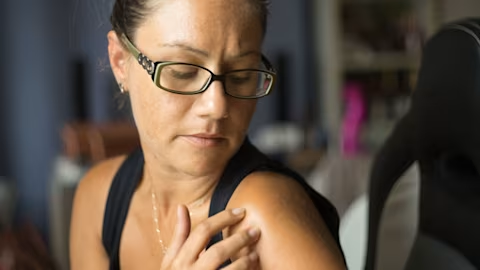How to fix a sore neck
Expert advice on preventing or fixing neck pain

Have you ever found yourself with a pain in the neck? And no, we don’t mean an annoying colleague, a tantrum-throwing toddler or a telemarketer who won’t stop calling you.
Neck pain is a condition that affects one in three of us, opens in a new tab each year – and when left untreated, it can be debilitating.
The good news is that there are things you can do to treat, manage and prevent neck pain before it worsens. That’s why we spoke with some experts to find out what you need to know.
Causes of neck pain
Poor posture
“By far the most common issue I see causing neck pain is postural,” says Chiropractor Mitchell Foord from Pacific Sport and Spine, opens in a new tab. “Whether it’s sitting in front of a TV, working on a computer or reading a book, having a rounded back with a forward head carriage is going to strain the neck and back."
Physiotherapist Chris Morton of Ethos Health, opens in a new tab agrees that bad posture is the number one source of neck pain in his clients. “Because people spend so much time on devices, they’re typically looking down into their lap.
“With overuse or fatigue, the muscles themselves can be a source of pain, while the excessive loading can irritate other sensitive structures around the neck, causing neck pain and headaches.”
Injury or trauma
Whether you’ve been in a car accident or you’ve simply had a trip and fall – injury and trauma can include anything that jolts the body around.
Delayed onset muscle soreness (DOMS)
There’s a difference between ‘bad pain’ and delayed onset muscle soreness (DOMS), which is the pain that sets in several hours after a workout.
“DOMS typically occurs 24-48 hours after heavy lifting and it’s a constant dull ache,” says Mitchell. “You should experience DOMS less and less the more you workout, as the muscles get used to the movements you’re doing. If the pain lasts longer than a few days, you should consider getting looked at by a health professional.”
Sleeping position
Sleeping on a mattress or pillow that doesn’t support the natural curves of the spine can cause neck stiffness. Usually if you wake-up with neck pain, as opposed to noticing it develop throughout the day, it’s a sign that it’s related to sleeping rather than poor posture.
Stress
A common physical side-effect of stress is muscle tension and when this occurs in your shoulders or neck, it can lead to neck pain.
Arthritis or cervical spondylosis
In some cases, neck pain can signify an illness that needs medical attention. A common cause of neck pain related to ageing, opens in a new tab is cervical spondylosis, which is arthritis of the neck. If you’re concerned about this, it’s important to see your GP for further testing.
How can I treat neck pain?
There are many options when it comes to treating neck pain. Everyone is different and the best pain management plan is the one that works for you and your lifestyle.
We’ve outlined a few of the most common ways to seek help.
Visit your General Practitioner
Your GP will be focussed on diagnosis and referral rather than hands-on pain relief.
See a physiotherapist
A physiotherapist can do anything from hands-on tissue work to educating you and giving you exercises to strengthen and release your muscles at home.
“It’s about figuring out which tissues are injured or irritated, helping patients reduce the load on those tissues, providing education on relevant risk factors, and sometimes strapping or taping to support good posture,” says Chris.
“We also use a range of manual therapy physio techniques to improve patients’ range of movement, and give them exercises to strengthen the muscles that support good head, neck and shoulder position.”
See a chiropractor
We often think of chiropractors in terms of ‘cracking’ (muscles or joints), however licensed chiropractors use a variety of techniques to lengthen and strengthen muscles and manipulate joints to relieve pain.
“Treatment can involve soft tissue techniques to release tight muscles, allowing you to strengthen the muscles that have been underutilised,” says Mitchell. “We can also look at releasing the thoracic spine which influences the position of the neck.”
The advice used to be ice for inflammatory conditions and heat for muscular, however current research says try both and see which works for you.
Use hot or cold packs
“The advice used to be ice for inflammatory conditions and heat for muscular, however current research says try both and see which works for you,” says Mitchell.
Do some gentle stretching
Gentle stretches can be effective, but listen to your body and stop if the stretch causes pain – pushing through a painful stretch can potentially prolong your recovery time. Some people find it good to stretch after a shower when the muscles are warm.
Over the counter medications
Simple analgesics such as paracetamol or anti-inflammatory medication may help relieve pain in the short term – always consult with a healthcare professional before use and do not use long term. Analgesic creams like Deep Heat can also provide relief.
Tips for preventing neck pain
Set reminders for good posture
Set an alarm reminder for intervals throughout the day to check your posture.
Use the screen that best fits the purpose
“If you’re watching an episode of a TV show, it’s much easier to do that with better posture if you put it on TV rather than watching on a phone or iPad on your lap,” says Chris.
Improve work station ergonomics
If you work at a computer, aim to have the top of the screen at eye level and at an arm’s distance from your body. Consider raising your laptop on a platform, and plugging in an external keyboard. Read more in our article on desk ergonomics.
Get up every half hour
If you’re sitting for long periods, Chris suggests getting up every half hour and moving around for a minute to reset.
Get the right mattress and pillow
“What you want is to keep your neck in a neutral position. The ideal pillow has a bit of a shape to support that natural curve,” says Mitchell.
If you’re experiencing neck pain that’s severe, lasts for several weeks or is accompanied by other symptoms such as fever or numbness in the arms, opens in a new tab, visit your GP or health professional for expert advice.

How improving your gut health can help support your immune system
70 per cent of our immune function is centred in the gut

Stay skin-safe: a guide to skin cancer self-checks
Catching skin cancer early makes all the difference.

How to have a healthier relationship with alcohol
Find a balance with healthier drinking habits.